12 May, 2025 | Admin | No Comments
Which high street coffee shop has the best value loyalty card scheme?



High street coffee shop loyalty schemes are 10 a penny, and you may find that you end up with an abundance of loyalty cards weighing down your purse.
Each scheme offers you points every time you buy a coffee, with the reward of a free coffee – and more – when you fill up the card.
Different coffee shops require you to buy a different amount of coffee before bagging a free one, and some offer points for other things as well.
With increasing costs, choosing which café chain to visit based on value-for-money is more important than ever. Let’s take a look at what each loyalty card scheme offers.
Which coffee shop has the best value loyalty card?
We looked at loyalty schemes from Costa, Starbucks, Caffè Nero, McDonald’s, Greggs, Grind, and Pret A Manger and have ranked them here in order of best to worst value.
1. Greggs

Greggs offers loyalty scheme customers freebies on coffees, pastries, and more.
You just have to buy nine items in the same category (for example, nine coffees) and you get the tenth free.
How much do you need to spend to earn a freebie?
The cheapest coffee at Greggs is a Regular Americano, which costs £1.50, so you would have to spend £13.50 to get a free coffee.
2. Starbucks

At Starbucks, for every £1 you spend, you collect 10 stars. At 130 stars, you get a free drink – anything from filter coffee, hot teas or a signature Americano.
Starbucks also charges 5p extra for customers who use a takeaway cup. Customers who bring their own reusable cup receive a 25p discount.
How much do you need to spend to earn a freebie?
An Americano costs £3.80 at Starbucks, so you would have to buy 4 of these before getting a freebie. This would cost £15.20. By bringing your own reusable cup, that would go down to £14.20.
3. McDonald’s

Being a fast food chain, McDonald’s doesn’t just serve coffee. Their MyMcDonald’s Rewards scheme is a loyalty programme that allows customers to earn one point for every penny they spend at participating stores.
But, say you are just after a coffee, their cheapest product is either a White Coffee or an Americano, at £1.39 each.
According to the scheme, you need 1,500 points to redeem either a small portion of fries, a medium salad, a regular McCafé, a mini McFlurry, a hash brown, or a regular drink.
How much do you need to spend to earn a freebie?
To earn 1,500 points, you need to spend £15. So, that’s 11 coffees, equating to £15.29.
4. Caffè Nero
Caffe Nero‘s loyalty scheme requires you to get nine stamps (one nine coffees since one coffee = one stamp) before getting a coffee for free.
However, it also gives you an extra point for using a reusable cup, meaning you only actually have to buy five coffees to get one free.
You can also get a free coffee just by downloading the Caffè Nero loyalty scheme app using a referral link.
Additionally, you can get free drinks for each friend you refer who also signs up and makes a purchase, meaning you can technically get multiple free coffees from Caffè Nero without spending a penny.
How much do you need to spend to earn a freebie?
The cheapest coffee at Caffè Nero is a regular Americano at £3.60, meaning that, if you used a reusable cup every time you bought a drink, you would have to spend £18 to be entitled to a free coffee.
5. Pret
Pret‘s loyalty scheme – aka ‘Pret Perks’ – gives you a star every time you buy something in store and scan the code in your Pret app.
If you get 10 stars, you get a perk (which could be anything from a free croissant to a coffee).
You can also join The Half Price Coffee Club. For just £5 per month, take advantage of up to five hot or iced Barista-made drinks a day with 50% off.
How much do you need to spend to earn a freebie?
The cheapest coffee at Pret is a filter coffee at £1.90, meaning you would have to spend £19 in-store to get a freebie.
Pret does offer a 50p discount to those who use a reusable cup in store though, so if you used one every time you bought a filter coffee, this would cut the price of a free treat down to just £14.
6. Costa
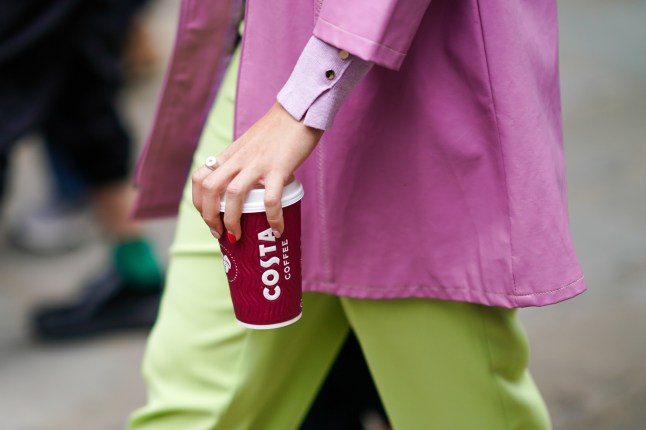
Costa‘s loyalty scheme says customers need to get 10 ‘beans’ to claim a free coffee (each coffee purchased = 1 bean).
However, if you bring your reusable cup, you get an extra bean, so you could get a free drink by just buying five coffees.
How much do you need to spend to earn a freebie?
The cheapest coffee at Costa is an Americano at £3.80, meaning that if you brought in a reusable cup every time, you will have to spend at least £19 (five Americanos, each with reusable cups) to get a free coffee.
7. Grind
London-based coffee chain Grind gives loyalty scheme customers one point for every £1 spent in-store.
You have to get 35 points to get a free coffee, meaning you have to spend £35 to bag a freebie. This could include a coffee, an Espresso Martini, ten of Grind’s compostable coffee pods or a pouch of coffee.
How much do you need to spend to earn a freebie?
The cheapest coffee on the menu at Grind is an Americano at £2.40, so you would have to buy 15 of these before being entitled to a free coffee. This adds up to £36.
11 May, 2025 | Admin | No Comments
Map reveals the UK loan hotspots where people borrow the most money


Searches for the term ‘I need a loan’ surged by 35% in the past three months, reflecting a growing reliance on borrowing to navigate financial challenges.
This is evidenced by the latest Pepper Money lending study, which found that more than half of Brits saw a drop in disposable income last year; and higher bills are hitting the nation’s pockets hardest.
As a result, a third of UK households have borrowed to pay for food or utilities, while 16% say their debt has increased ‘a lot’ over the previous 12 months.
According to the lender’s data, the average loan taken out in 2024 sat at £41,088, with the most common reason given being debt consolidation (accounting for around half of the total) followed by home improvement (making up 9.7%).
Loans for property purchases or investment and those to fund travel or weddings are also becoming more common, as is medical-related borrowing to pay for private care.
However, it seems that residents in some cities were far more inclined to borrow than others.
Brummies were responsible for almost one in eight loans across the UK last year, with the average amount coming to £40,393.
Here, weddings were the most common reason for borrowing – a stark contrast to Sheffield (which accounted for the second-highest proportion with 10.5%) where it was medical bills.
Next up, Cardiff came in third with 9.5% of the country’s loans, and the top five was rounded off by Newcastle and Nottingham, which racked up 8.5% and 8.2% respectively.
Perhaps surprisingly, London didn’t make the top 10. But although the capital made up just 3.9% of 2024 loans, the ones that were taken out were the largest among the cities studied, averaging at a whopping £61,681.
Commenting on the findings, Ryan McGrath, sales director at Pepper Money, says: ‘We’re seeing more households in cities like Birmingham, Sheffield, and Cardiff using loans not just to consolidate debt, but also to invest in their homes and even fund major life events.
‘Rising costs mean people are looking for smarter ways to borrow, and secured loans are becoming a more popular option for homeowners who want to access larger sums at lower rates.
Latest London news
- Final look of London’s iconic BT Tower before sale to hotel chain for £275,000,000
- British Airways pilot caused plane to catch fire after mixing up left and right
- 12 best things to do in London this weekend including ‘stunning’ rooftop bars
To get the latest news from the capital visit Metro’s London news hub.
‘The key is ensuring that any loan, whether for home improvements, debt consolidation, or personal milestones, is the right fit for their financial situation by seeking financial advice.’
The UK's top 10 loan hotspots for 2024
- Birmingham
Total loan %: 12.5%
Average loan amount: £40,393 - Sheffield
Total loan %: 10.5%
Average loan amount: £35,077 - Cardiff
Total loan %: 9.5%
Average loan amount: £36,636 - Newcastle upon Tyne
Total loan %: 8.5%
Average loan amount: £37,669 - Nottingham
Total loan %: 8.2%
Average loan amount: £35,794 - Glasgow
Total loan %: 7.9%
Average loan amount: £37,100 - Leicester
Total loan %: 7.8%
Average loan amount: £42,057 - Manchester
Total loan %: 6.8%
Average loan amount:£39,317 - Bristol
Total loan %: 5.8%
Average loan amount: £48,102 - Edinburgh
Total loan %: 5%
Average loan amount: £41,011
Do you have a story to share?
Get in touch by emailing MetroLifestyleTeam@Metro.co.uk.
11 May, 2025 | Admin | No Comments
Brits could save £868,000,000 a year with these kitchen cupboard cleaning swaps



A limescale remover here, an oven cleaner there, and before you know it, you’ve got a kitchen cupboard full of cleaning products gathering dust.
As a nation, we’re so addicted to throwing these chemical-heavy items in our trollies, that we waste almost £868 million a year on unused bottles.
Brits collectively spend £2 billion – an average of £54.20 each – on household cleaning supplies, but according to research by Smol, half of it will go to waste.
This amounts to an average of £22.30 worth of products sitting unused, with just 3.9 cleaning products being used on a regular basis, the study of 2,000 adults found.
Want to clean up your act and save some pennies? Here are eight ways to clean your home using kitchen staples for less.
1. Bust limescale with lemon
To get rid of limescale build-up on bathroom and kitchen taps, look to lemons.
Simply cut a fresh lemon in half and use your thumbs to gently open up the centre of one of the halves. Then press the lemon on to the end of the tap, wrapping a small plastic bag around it with a rubber band to hold it in place. Be sure that the rubber band is cinched tightly and that the lemon is around the end of the tap.
Leave for a few hours to allow the citric acid to work its magic. After you remove the lemon, you may need to use a gentle scrubbing pad to wash off any loosened limescale build-up.
Finally, wipe the tap with a damp cloth to remove any leftover lemon juice, and your taps will be squeaky clean.
2. Clean your oven door with a kitchen staple
All you need for this hack is a bowl of warm water and a dishwasher tablet (or two) – just make sure that whichever brand you use, you buy the pressed powder tablets and not the gel pods.
Simply dip the pod in the warm water and allow it to soak up some water, but don’t leave it for so long that it starts to crumble.
Now remove the tablet from the water and lay it flat against the oven door. Use your palm to move the tablet in a circular motion to scrub away the stains. If the tablet starts to dry out, dip it in the warm water again. This method works on glass and is also effective on the surrounding metal part of the oven door.
When you’re finished, wipe away any residue with a damp cloth.
3. Neaten up your knives
Combining cream of tartar, baking soda and hydrogen peroxide makes an excellent – and natural – solution for removing rust on metal surfaces, such as your kitchen knives.
Simply put some cream of tartar in a bowl with equal parts baking soda, then add hydrogen peroxide, a little at a time, until you achieve a paste-like consistency. Rub this mixture over the rusty knife, let it sit for an hour, then wash in the sink.
4. Tackle burned-on food with a dishwasher tab
Burned food stuck to a saucepan can be a pain to remove, and scrubbing it could ruin the pan, so try using a dishwasher tablet to lift the residue.
Simply fill your saucepan with water, pop a dishwasher tablet in, then place it over a medium heat and leave to simmer for 10 minutes. This will loosen the burned remnants so it’s easy to wipe them off.
Make sure to check the manufacturer’s instructions for your saucepan before you do this, though, particularly if you have a non-stick saucepan, as you don’t want to damage the coating.
5. Shift stains in food containers
Is there anything more annoying than a newly stained plastic container?
All it takes is some leftover Bolognese sauce, and then no matter how hard you scrub, that container seems destined to remain orange-red forever.
But fear not – according to tasteofhome.com, you can banish the stains from your plastic containers, and they will look as good as new in no time. Just add soap and warm water to the tub, toss in a few pieces of torn-up kitchen roll, pop the lid on and give it a good shake for about a minute.
Empty the contents, rinse the inside and hey presto! No more stains.
6. Say goodbye to black scuffs
WD-40 isn’t just for sticky spots – it’s also handy for any tough black scuff marks on your kitchen floor left by those who insist on wearing their shoes indoors.
If you spray the marks with WD-40 before cleaning, you won’t have to scrub nearly as much – and it won’t damage the surface.
7. A splash of vinegar to save the load
White vinegar is a versatile and cost-effective solution for laundry care. Adding a cup of white vinegar to the rinse cycle can significantly enhance the softness of your clothes while effectively removing stubborn odours.
The acetic acid in vinegar helps to break down detergent residues and mineral deposits, which can make fabrics feel stiff and rough.
Additionally, vinegar’s natural deodorising properties neutralise unpleasant smells, leaving your laundry fresh and clean.
8. Sock it up
Cleaning blinds can be a tedious task, but using a simple vinegar and water solution can make it much easier and more effective – and a sock will save you loads of time.
To start, mix equal parts white vinegar and water in a bowl.
Then, take an old sock or glove and dip it into the solution. This makeshift cleaning tool is perfect for wiping down each slat of the blinds, allowing you to reach all the nooks and crannies.
The vinegar works as a natural disinfectant and degreaser, cutting through dust and grime effortlessly.
Do you have a story to share?
Get in touch by emailing MetroLifestyleTeam@Metro.co.uk.


Whilst it may not be the most exciting birthday present, UK residents typically receive their National Insurance number shortly before they turn 16.
This usually happens when a parent or guardian has filled out a Child Benefit claim form on your behalf.
If you haven’t received one by then, or if you didn’t grow up in the UK, you will need to apply for one yourself.
In this article, you’ll learn all you need to know about your National Insurance number (NIN), from why we need one, where to find it, and the most important question of all: how much National Insurance do we pay?
What is a National Insurance number?
A National Insurance number identifies individuals within the UK’s social security system.
It’s unique to every person, and it’s needed to ensure your National Insurance – a tax on earnings and self-employed profits – is recorded against your name. A NIN is necessary to make sure the correct amount of tax is deducted from your earnings. The last thing you want is to be giving away too much of your hard-earned cash, right?
Having a National Insurance number is also really beneficial, as it allows you to access social security benefits, including information on your State Pension and payroll details.
What does a National Insurance number look like?
The number is made up of two letters, six numbers and one final letter, and remains the same for life. For example, QQ123456B.
For those aged 16 to 19 without one, the Government website recommends applying online.
When do you start paying National Insurance?
You start paying for National Insurance (NI) if you’re over 16 years old and earning or receiving self-employed profits over a certain amount.
You have to pay mandatory NI if you are:
- An employee earning above £242 a week from one job
- Self-employed and making a profit of £12,570 a year
NI goes towards funding public services like the NHS, pension schemes, unemployment benefits and sickness and disability allowances.
If you are paid through a Pay As You Earn (PAYE) system, NI contributions are automatically deducted from your salary, so you won’t need to do anything to ensure you’re paying it.
You should see your NI contribution deducted from your pay cheque.
If you’re self-employed, then your NI contributions will be calculated based on your Self Assessment tax return.
When do you stop paying National Insurance?
As per the Government website, you stop making NI payments from 6 April (start of the tax year) after you reach State Pension age, which is currently 66.
You do not pay NI after 66 – unless you’re self-employed and pay Class 4 contributions (meaning your profits are more than £12,570 a year).

How much National Insurance do you pay?
The amount of NI you pay depends on your employment status and how much you earn.
Employers also pay NI at a different rate, based on the earnings of their employees.
As for how much you pay exactly, let’s break it down. From 6 April 2025 to 5 April 2026:
• If you’re employed: Employed people pay Class 1 NI. If you earn £242 to £967 a week (£1,048 to £4,189 a month), your rate is 8%. If you earn more than £967 per week (£4,189 a month), it’s an additional 2%.
• If you’re self-employed: Self-employed people who make over £12,570 a year pay Class 4 NI. If your profits are £6,845 or more, your Class 2 contributions are treated as having been paid to protect your NI record. If your profits are less than £6,725 a year, you do not have to pay anything but you can choose to pay voluntary Class 2 contributions. Most people pay via Self Assessment, but how much you contribute depends on your profits.
• If you’re employed and self-employed: Many people fall into both categories. This means your employer will deduct your Class 1 NI from your wages, while you may have to pay Class 4 for any self-employed work. How much you pay depends on the combined wages. But don’t worry, HMRC will tell you exactly how much you owe once you’ve filed your Self Assessment tax return.
You can use a calculator from Which? to help get an estimate on how much you will pay.
Where to find your National Insurance number
You can find your NIN on multiple documents, from P60s, payslips, tax letters, pensions and benefits.
If you have the HMRC app, you can locate it on your personal tax account.
If none of these apply, you can request an online or mail copy from HMRC.
10 May, 2025 | Admin | No Comments
Energy suppliers to refund households £7,000,000 after overcharging customers



Ten energy suppliers are paying customers £7 million in refunds after overcharging them for five years.
More than 34,000 customers across the UK with at least two electricity meters in the property overpaid their bills between 2019 and 2024.
Ofgem said customers were ‘erroneously charged more than is allowed under the price cap when combined with unit rates’.
After investigating the issue, suppliers agreed to issue £5 million in refunds and £1.4 million in goodwill payments.
Octopus Energy had 20,862 most customers affected, and will pay out £2.6 million in total refunds.
Eon Next, Ecotricity, EDF, Outfox the Market, Ovo Energy, Rebel Energy, So Energy, Tru Energy and Utility Warehouse are also issuing refunds.
Which energy suppliers overcharged customers?
Eon Next – 160 customers affected
Total Refunds – £45,195.82
Total goodwill payments – £9,330.33
Ecotricity – 166 customers affected
Total Refunds – £36,633.12
Total goodwill payments – £18,904.35
EDF Energy – 3 customers affected
Total Refunds – £112.29
Total goodwill payments – £30.00
Octopus Energy – 20,862 customers affected
Total Refunds – £2,636,884.00
Total goodwill payments – £546,278.00
Outfox The Market – 570 customers affected
Total Refunds -£6,106.06
Total goodwill payments – £4,590.00
Ovo Energy – 2,372 customers affected
Total Refunds – £602,066.05
Total goodwill payments – £280,068.73
Rebel Energy – 15 customers affected
Total Refunds – £2,339.49
Total goodwill payments – £575.00
So Energy – 1,558 customers affected
Total Refunds – £266,041.16
Total goodwill payments – £58,285.85
Tru Energy – 70 customers affected
Total Refunds – £7,486.54
Total goodwill payments – £11,663.00
Utility Warehouse – 8,272 customers affected
Total Refunds – £2,043,098.84
Total goodwill payments – £453,960.00
Charlotte Friel, director of retail pricing and systems at Ofgem, said: ‘We expect all suppliers to have robust processes in place so they can bill their customers accurately.
‘While it’s clear that on this occasion errors were made, thankfully, the issues were promptly resolved, and customers are being refunded.
‘Today’s outcome serves as a reminder to all energy suppliers that they must implement the price cap properly and do their due diligence.
‘It also shows that, where appropriate, Ofgem is prepared to work with suppliers that fail to comply with our rules.’
Who is eligible to get a refund?
Affected customers will be refunded automatically.
If customers have since changed supplier, they will be contacted by their previous company to arrange a refund.
Rebel Energy, which closed last month and left 90,000 homes without a supplier, will be refunded.
Get in touch with our news team by emailing us at webnews@metro.co.uk.
For more stories like this, check our news page.
9 May, 2025 | Admin | No Comments
Major energy company is offering two hours free a week to help lower bills



After bills increased again at the start of last month, many households across the country continue to struggle with the cost of living crisis.
April 1 was dubbed ‘Awful April’ thanks to household bills like energy, water and council tax increasing.
Some energy companies have also been forced to pay out £7million for overcharging around 34,000 customers.
While summer is approaching, one energy supplier, OVO Energy, is offering customers two hours of free electricity each week.
But how will this work for customers who use the energy supplier?
We take a look below.
Who is eligible?

The free electricity is only open to people who are signed up to the company’s reward programme, OVO Beyond, which was set up in May 2024.
For those who are not signed up already, you can do so through the OVO app.
When are the free hours?
Customers are able to choose their time slots from week to week but they will only be offered off peak slots.
It will run from May 5 until August 31 and equates to a maximum of 34 hours of free electricity this summer.
So for those who work in the office or are not in the home much this might not be beneficial.
What are the peak hours of energy use?
Peak energy use times tend to be in the morning when people are getting ready for work and school between 7am and 9am, according to British Gas.
Popular times also occur during the evening around 4pm to 7pm as people get home and make evening meals.
Demand during these hours can lead to strain on the electricity grid and increased prices.
Late at night or early morning tends to be when less energy is used by households across the country.
There are hours in the late evening and on Sunday though that can be used for free.
The reason this is the case is that during peak hours, there’s not enough renewable energy around, which results in fossil fuel use.
The following time slots are available to choose from each week:
- 9am – 10am on specified weekdays
- 1pm – 2pm on specified weekdays
- 9pm – 10pm on specified weekdays
- 10am – 12pm Sundays
How to sign up?

People need to sign up to OVO Beyond to book a free time slot which is free to do.
For those who pay by direct debit or have a smart meter, OVO Beyond unlocks automatically in the app.
The free electricity is also subject to a limit of 1kWh per hour and the hours must be confirmed within the set window.
Those signed up will also be offered other perks like OVO Power Move, which offers various rewards via a prize draw – including a year’s worth of free energy – for those who use energy at greener times of the day.
Get in touch with our news team by emailing us at webnews@metro.co.uk.
For more stories like this, check our news page.
9 May, 2025 | Admin | No Comments
What I Spent: The wedding you actually get for £5,000, £20,000 or £50,000
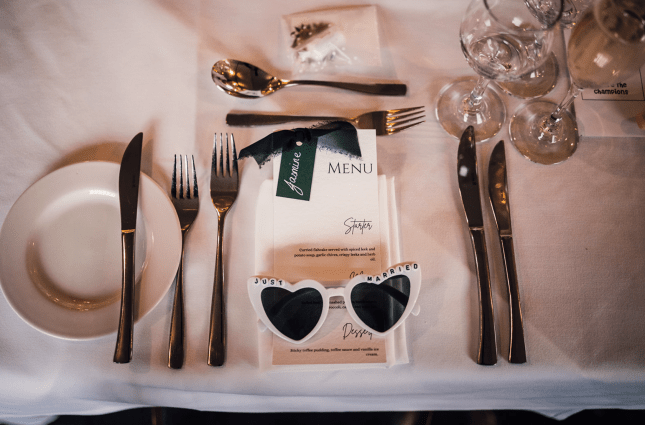


The average wedding in the UK now costs £23,250 – almost £6,000 more than in 2021.
That doesn’t tell the full story though, as according to Bridebook, a quarter of couples will spend less than £10,000 on their special day, while 10% have a budget of £5,000 or under.
At the opposite end of the spectrum, 10% of ‘nearlyweds’ will fork out over £38,000 for their 2025 nuptials.
But whether your budget is tight or pretty much nonexistent, it can be difficult to find out what you actually get for your money.
So to take away the mystery and bust the taboo of talking marriage and money, Metro asked three brides what they spent on their weddings, as well as advice they’d give to others tying the knot.
Budget: £5,000
Catherine Ramm, 52, owner of Dorset Dried Flowers from Corfe Castle, Dorset, got married in 2023.
In total, she and her partner ended up spending less than £6,000 on a large wedding with 120 day guests and 300 evening guests.

As Catherine’s a florist, she was able to do the bouquets and decor herself, while her now-husband is a farmer, meaning they saved on venue costs by holding their ceremony and reception on his land.
The pair’s friends and family also donated services or helped out with mate’s rates on everything from photography to toilets.
‘We had no budget in mind when we started planning,’ Catherine tells Metro. ‘It just sort of evolved, and we had so many people wanting to be involved it was amazing.’
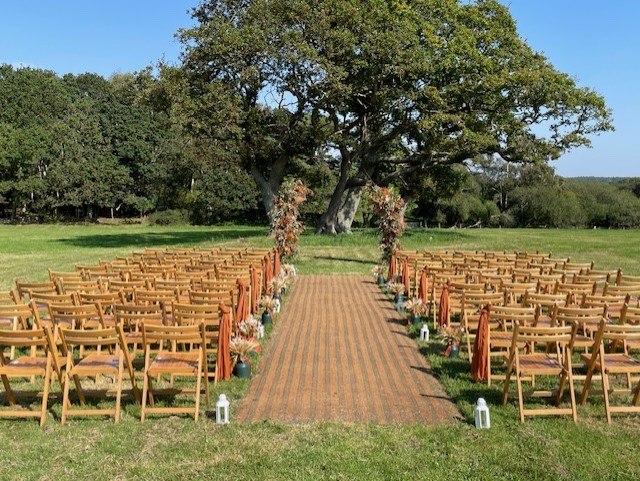
She’s over the moon with how it all turned out, adding: ‘People are still talking about it. We had an amazing time and I don’t think we could have made it any better even if we had thrown more money at it.’
Although Catherine didn’t specifically plan to spend so little on her big day, she does have some advice for others who want to keep costs down.
‘Look at where you aren’t prepared to compromise and where you are,’ she says. ‘There are places you can cut the corners and places you can’t.’
Catherine's budget breakdown
Venue: £3,500
We paid £3,000 for the marquee on our own land and £500 for a generator. Toilets were donated by a friend.
Registrar/celebrant: £270
We got married officially on the Thursday at Poole registry office, which cost £270. On the Saturday, a friend of ours who is a celebrant did the ceremony as a favour.
Catering: £950
Alongside a hog roast which cost £650, one of our friends on the farm gave us venison, shot and butchered, as a wedding present.
We then had afternoon tea with sandwiches from local baker (£100), scones from local tea rooms (£100), sausage rolls made by a friend, and cupcakes from a local maker £100)
Photography and/or videography: £0
Photography was done by a friend who was a professional photographer years ago, and friends also shared their images.
Flowers and venue decor: £500
This was all done by me, so costs were minimal.
Invitations and stationery: £50
I made the invitations myself using a bespoke stamp which I had made by a company online, then some lovely paper and an ink pad.
Wedding cake: £100
A friend made this for the cost of the ingredients.
Entertainment: £210
We had a singer who was ‘paid’ with four nights free camping on the farm. The band were friends, so we got a discounted rate of £60. We also had a fire dancer which was £150.
Bride and groom attire: £120
My dress cost £100 in a sample sale, and my husband’s suit was £20 on Vinted.
Bridal party and groomsmen attire: £11
My daughter’s bridesmaid dress was £11 on Vinted, and the rest of our children wore suits and dresses they already had.
Transport: £0
We got around the venue on a farm buggy which we already had.
Rings: £0
My husband doesn’t have one as he is a farmer, and he will lose it – it’s also dangerous with machinery. Mine were my engagement rings – he got me three silver rings – and I just used these, as I don’t need any more
TOTAL: £5,711
Average: £20,000
Jasmine Granton, a 31-year-old Digital PR Consultant from Mansfield, got married to her partner of 12 years in November last year.
In total, they spent just under £19,000 on a wedding of 100 guests at the West Mill in Derby.
While she and her now-husband didn’t have a set budget, they ‘didn’t want to spend a fortune’ on the day itself, ideally keeping money aside for the month-long Vietnam honeymoon they’d always dreamed of.

‘Deep down, we did want a big wedding though,’ Jasmine tells Metro. ‘And we both have large families so we were always going to have a guest count of around 100 – which inevitably brings the price up.’
The couple created a spreadsheet listing everything they might need with the maximum they’d be happy to spend on each point. But as anyone who’s planned a wedding knows, some things were more expensive than expected while in other areas, they managed to save.
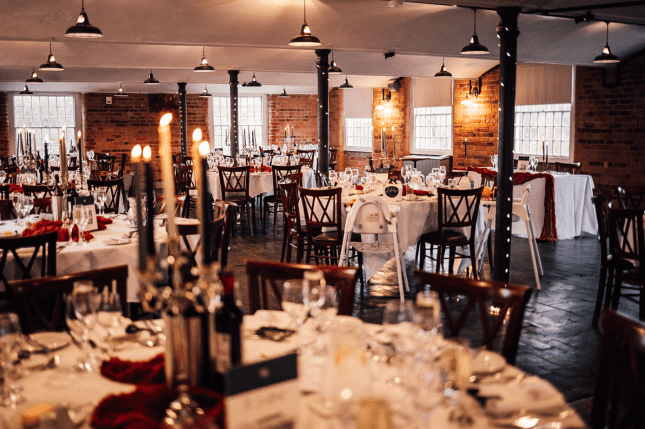
‘I feel so happy with what we got for our money,’ says Jasmine.
‘Making some pretty big decisions at the start – like having the wedding in winter on a Monday – meant we could make other decisions like booking a photographer and videographer we loved, because for us, the photography was so important.’
Alongside this, she kept costs down by making her own stationery, customising cheaper items, and doing a lot of the planning herself.

She recommends other brides and grooms-to-be stay true to what you want and ‘don’t pay for anything that you feel you’re doing just for the sake of it’ or ‘compromise for other people’.
Jasmine continues: ‘If you don’t want a cake, don’t have one. If you don’t want that long distance friend who hardly makes the effort to see you, don’t invite them.
‘The biggest compliment we got (and still get) about our wedding was that it felt “us”, and that’s because we prioritised the things that made us happy.’
Jasmine's budget breakdown
Venue: £2,800
Our venue hire was around £2,500. We got married on a Monday in winter which drastically changed the cost, as I believe in peak wedding season it’s closer to £9,000.
We also paid to stay in a large house with our family, but they paid for their rooms so this cost us around £300.
Registrar/celebrant: £450, including licences
Catering: £7,800
In total, food came to £5,800 while drinks were £2,000.
Photography and/or videography: £2,400 for both
Flowers and venue decor: £600
I bought most of the decor – including candle holders, mirrors, and candles – secondhand from Facebook Marketplace (£300 in total) and did a lot of upcycling, such as turning the mirror into our welcome sign and seating plan.
We didn’t have flowers around the venue, just lots of candles and mirrors as that’s more our style. In terms of bouquets, I had dry flowers for me and my bridesmaids which came to £300.
Invitations and stationery: £70
I designed these all myself using Canva, so the only cost was for paper and printing.
Wedding cake: Roughly £30
We decided not to have one – who even eats it?! – but had a prosecco tower instead, which just cost us the amount of the few bottles of prosecco as the venue had no corkage fee
Entertainment: £700
It was £600 for a singer in the day who did a music bingo which was such a party starter, and we somehow got a brilliant DJ for £100!
Bride and groom attire: £1,562
I bought my wedding dress from a website called Stillwhite – it had tags on and was unaltered but cost me £1000 instead of £1800. I then got my veil second hand for £12, my shoes were £50 and my jewellery was kindly gifted to me.
My husband’s suit and shoes came to around £500.
Hair and makeup: £600
Bridal party and groomsmen attire: £1,300
ASOS suits for two best men and two groomsmen and three bridesmaid dresses came to £700.
Transport: £0
We didn’t have any.
Rings: £300
TOTAL: £18,612
Splurge: £50,000
Krissie Williams-Stewart, a 36-year-old homemaker from Coventry got married in December last year.
She and her now-husband Frankie spent £50,000 on their dream wedding, which was held at Merrydale Manor, Cheshire and had 91 guests in attendance.
‘We had a budget in mind from the very start,’ Krissie tells Metro. ‘But I hadn’t ever looked at anything wedding-related before, so I was completely clueless when it came to the real costs of anything.’

Although their big day ended up costing more than double the average, she says ‘it was worth every single penny’.
‘I have absolutely no regrets about what we got for our money,’ adds Krissie. ‘Our day was a complete fairy tale, and my vision completely came to life.’

In terms of advice, she stresses the importance of prioritising.
‘Write down your non-negotiables and focus on those; and then see what you have left for all the other bits,’ she explains. ‘If your dream venue is expensive, then consider a weekday or slightly out of wedding season to get a better price.’
Keep an eye on the ‘little things’ and DIY what you can too, as personal touches from favours to table settings ‘add up fast.’
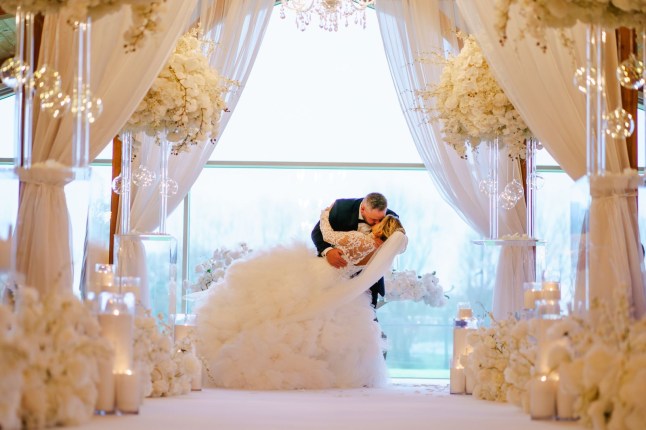
Krissie continues: ‘As tempting as it is to book everything, you really don’t need to… Guests honestly enjoy mingling and having a chat with each other, so don’t go overboard thinking you need entertainment for every second.
‘We did this, and to be honest, it did make the day seem very busy, as there was so much going on all the time.’
‘That being said, never ever skimp on the photographer,’ she adds. ‘These photos are for life, so it’s definitely worth the investment.’
Krissie's budget breakdown
Venue: £13,000
Registrar/celebrant: £650
Catering: £12,000
It was £9,000 for food and drinks during the day and £3,000 for the evening.
Photography and/or videography: £3,700
The photographer came to £2,500 and the videographer was £1,200.
Flowers and venue decor: £5,350
We paid £4,500 for all the flowers – including bouquets. Other decorations were hired for £850.
Invitations and stationery: £400
Wedding cake: £300
Entertainment £4,300
A musician for the ceremony was £800, and for the reception was an additional £2,000. Additional entertainment came to £1,500.
Bride and groom attire: £5,400
My wedding dress was £3,500 and accessories were £1,000, while my husband’s suit was £900.
Hair and makeup: £2,200
Hairdressing came to a total of £1,500 and makeup was £700.
Bridal party and groomsmen attire: £1,500
Alongside this, my husband also hand-built a watch for every groomsman and the father of the bride to complete the look!
Transport: £600
Rings £450
Wedding planner: £300
TOTAL: £50,150
Do you have a story to share?
Get in touch by emailing MetroLifestyleTeam@Metro.co.uk.
6 May, 2025 | Admin | No Comments
I’m a foodbank volunteer and have to throw away 20% of our donations


Stale croissants mixed in with dying flowers.
Browning broccoli scattered with bashed up blueberries. Fizzy fruit salads. Wet, wilted bags of rocket and leaves.
Potato salad, or coleslaw, or cream or milk with the clock ticking down on its use-by date.
No, this isn’t a particularly disastrous online food shop. Dealing with this kind of unusable food – often in large quantities – is the true reality of working in a foodbank.
As the pantry manager at the foodbank at my church, I’m constantly battling for the food I need to feed people with balanced, nutritious meals.
Food is love, food is community, but food waste is far from either of those things and my role has become about waste minimisation and management.
Most of our food is donated by the big supermarkets. We go to them and boxes are already stacked up and ready to go. Usually they want us in and out, so we grab them, load them into the back of cars and head back to the church.

Then we pick through to see what’s actually suitable for giving out or incorporating in our meals, which we cook for the community twice a week.
Then we look at what can be composted and, finally, what needs to go in the bin or taken to the tip. Some weeks it’s 15 to 20% that’s wasted.
Although donations help provide food for those who need it in our community, having to wade through bad-smelling, curdling, out-of-date food to get to that point is frustrating.
This isn’t just happening in my church. New research from environmental charity Feedback – based on the lived experience of people just like me – found that the burden of damaged, out-of-date or nutritionally inadequate food is being unacceptably passed on by supermarkets and retailers to food aid organisations to deal with.
It found that 91% of organisations like mine have had to discard donated food, with the most common reason being that the food was damaged or inedible. Meanwhile, 85% reported feeling frustrated, angry or sad when they received donated food items that they can’t use or redistribute.
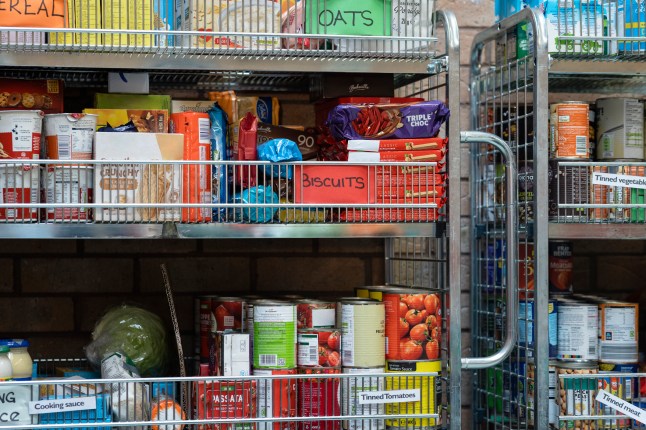
I took part in Feedback’s research, and am writing this because I want to sound the alarm on the reality of food distribution in this country.
Our food pantry and foodbank at the church has been open for over two years and in that time it has grown and grown. When we began, I wanted to open up the church and bring people in. My original vision was of a little fridge, a little freezer and teas and coffees.
How naïve I was. We now have two big fridges and two big freezers, as well as back ups.
We started advertising locally and I was shocked when 70 people turned up in the first week – so many people needed us. We now have over 50 volunteers and feed more than 200 people at a time. We sometimes have to turn people away.
Food bank guidance
- How to donate to a food bank and what foods do they need the most?
- How to find a food bank near you and how to get a voucher
- ‘I can’t afford to survive unless I come here’: how food banks are tackling the growing cost of living crisis
For more stories like this, check out Metro.co.uk’s cost of living page
I work in an area of deprivation where people have zero hours contracts and irregular job contracts. Sometimes you’ll get loads of hours, then none. No sick pay. Waiting weeks for benefits to kick in. People are being pushed into debt and unable to feed their families – with the cost of living sky high.
Child poverty levels in this country are shocking and the welfare cuts are only going to make that worse for the most vulnerable. Three hundred people came to eat at the church on Christmas Eve.
Though doing the work is fulfilling and necessary, sometimes it’s just all too much – the endless cycle of food collections, waste management and starting all over again.
I’m paid for 20 hours a week but I have regularly worked 60.
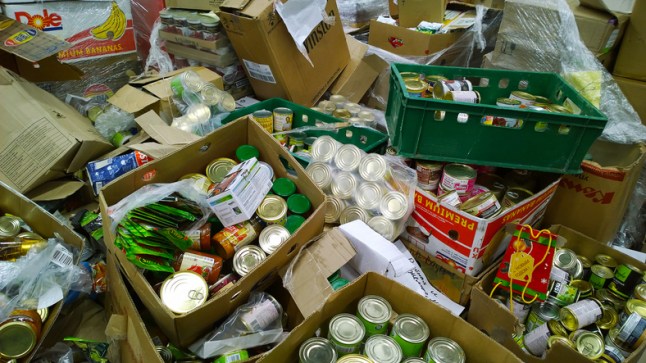
Luckily, I have our amazing volunteers around me and we share the load, supporting each other and picking each other up when we’re down. But our volunteers are often vulnerable themselves and they find the waste even harder than me.
The problem is the demand from supermarkets means food is being overproduced. Food is shipped to the UK from all over the world to rot in warehouses as it’s not being bought and eaten as fast as it’s turning up.
That is immoral – all that effort to grow it and it’s wasted.
Find out more
Learn more about what Feedback Global do here.
Some of our volunteers really struggle with the sheer amount of waste. Recently, one person was in floods of tears, saying that it wasn’t giving people any dignity, and she was right.
Most of our donations come from supermarkets or from redistribution charities like FareShare. The donations from charities are great – they’re of high quality and suitable for making, healthy nutritious meals.
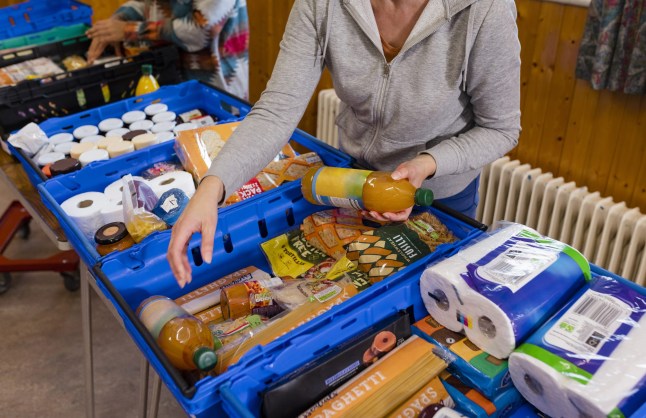
FareShare provides a personal touch with its community development officers and listens to what kinds of food you need.
We then get some food donated by our local community. Sometimes we get tins that are out of date – for example, from house clearances – but never rotting fruit and veg like from supermarkets.
I’m not an expert – and I don’t have all the answers – but the food redistribution model definitely isn’t preventing food waste and it’s not a sustainable way to feed people.
We need to tackle the root causes of poverty by making sure people have enough money to afford essentials – including food. This would take foodbanks out of the equation.
I’m in my 60s now and I’d love for a day to come when our foodbank isn’t needed – but it’s not going to happen. We’re inundated and things are going in the wrong direction.
Yes, foodbanks are brilliant. Yes, it’s humanity at its best. But they’re not the solution and we can do so much better.
Do you have a story you’d like to share? Get in touch by emailing jess.austin@metro.co.uk.
Share your views in the comments below.
6 May, 2025 | Admin | No Comments
Skull of legendary medieval king may have been unearthed at ruined church: expert
A skull was recently discovered at a medieval church – and an expert believes it may belong to a legendary European king.
Emese Gábor, a facial reconstruction specialist and portrait sculptor based in Hungary, spoke with Fox News Digital about the discovery.
The skull was found in the ossuary portion of the Basilica of the Assumption of the Blessed Virgin Mary in Székesfehérvár, Hungary. Gábor believes the skull belongs to Matthias Corvinus, who ruled as king of Hungary and Croatia from 1458 to 1490.
ARCHAEOLOGISTS UNCOVER CENTURIES-OLD SHIPWRECK BENEATH HISTORIC CITY: ‘UNIQUE SOURCE OF KNOWLEDGE’
Called Matthias the Just, the medieval king is known for restructuring the Hungarian army and ushering in judicial reforms.
The Basilica of the Assumption of the Blessed Virgin Mary, now an archaeological site, had been the burial site of Hungarian kings for centuries.
The site was raided by the Ottomans in the 16th century before it was destroyed by a fire in 1601.
ARCHAEOLOGISTS UNEARTH STRANGE HEAD DEPICTING ROMAN GOD BENEATH CATHOLIC BASILICA
Gábor told Fox News Digital she found an “exceptionally high degree of morphological similarity” between the unknown skull and the skull of Matthias Corvinus’ son, János Corvinus.
“[The skull’s] external characteristics are also of exceptional importance: the greenish discoloration observed on the bone surface likely indicates the presence of a metal crown once worn, which left traces through oxidation,” Gábor said.
CLICK HERE TO SIGN UP FOR OUR LIFESTYLE NEWSLETTER
The physical features of the skull also match what’s known about Corvinus, down to his age and height, she also noted.
“This phenomenon, along with other features — such as the estimated age at death (43–48 years; Mátyás died at age 47) and the body height of 172 cm — provide further support and reinforce the possibility of royal origin.”
For more Lifestyle articles, visit foxnews.com/lifestyle
Gábor also created plastic facial reconstructions of the examined skulls in an effort to help visualize the facial features.
“The comparative analyses … [were] based on detailed proportional and morphological evaluations, including the results of the facial reconstruction,” she said.
Researchers plan to study the skull further, Gábor added, including full genomic and mitochondrial DNA analyses and isotope analyses, to learn more.
“This research could shed new light on the appearance and person of Matthias Corvinus, and also on the historical treasures still hidden at Hungarian heritage sites,” the expert said.
6 May, 2025 | Admin | No Comments
MSNBC walks back 'misstatement' alleging FBI head Kash Patel spends more time at nightclubs than in the office
MSNBC’s “Morning Joe” Monday had to walk back an eyebrow-raising claim made the previous week about FBI Director Kash Patel.
On Friday’s edition of the morning talk show, Frank Figliuzzi, a former assistant director at the FBI, shared the claim that Patel had been seen out partying more often than working at the office.
“Reportedly, he’s been visible at nightclubs far more than he has been on the seventh floor of the Hoover building,” Figliuzzi told “Morning Joe” co-host Jonathan Lemire. “And there are reports that daily briefings to him have been changed from every day to maybe twice-weekly.”
NYC MAYOR ERIC ADAMS ADMITS THE DEEP STATE IS ‘REAL,’ CREDITS KASH PATEL’S BOOK FOR GETTING IT RIGHT
Figliuzzi, who is a national security and intelligence analyst for MSNBC, said his contacts at the FBI told him the agency was in a state of “chaos.”
“People don’t know what’s happening from day-to-day,” he added.
Figliuzzi’s comments were picked up by several media outlets last week. On Monday’s show, Lemire took a moment to retract those comments.
“Frank Figliuzzi was on that hour, discussing the work of administration officials,” Lemire began, referring to Friday’s “Morning Joe.”
“At the end of that segment, Figliuzzi said that FBI Director Kash Patel has been more visible at nightclubs than the FBI headquarters. This was a misstatement. We have not verified that claim,” Lemire said.
KASH PATEL, FBI TOUT $5M REWARD FOR CAPTURING MS-13 ‘TERRORIST LEADER’ UNLEASHING EVIL ON AMERICANS
MSNBC did not immediately return Fox News Digital’s request for comment.
FBI spokesperson Ben Williamson declined to comment.
Last month, Army Secretary Daniel Driscoll replaced Patel as acting director of the Bureau of Alcohol, Tobacco, Firearms and Explosives (ATF). A source close to Patel previously told Fox News Digital that the role was taken off of his plate so he could focus on his role as FBI director.